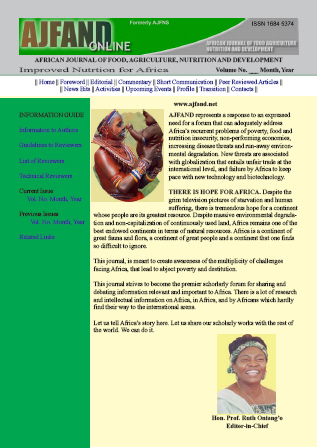
|
African Journal of Food, Agriculture, Nutrition and Development
Rural Outreach Program
ISSN: 1684-5358
EISSN: 1684-5358
Vol. 8, No. 1, 2008, pp. 63-76
|
 Bioline Code: nd08007
Bioline Code: nd08007
Full paper language: English
Document type: Research Article
Document available free of charge
|
|
|
African Journal of Food, Agriculture, Nutrition and Development, Vol. 8, No. 1, 2008, pp. 63-76
| en |
Acidification from Long-term Use of Urea and its Effect on Selected Soil Properties
Lungu, OIM & Dynoodt, RFP
Abstract
Soil acidity is one property associated with decline in soil fertility and low productivity. One important cause of soil acidity is the use of acid-forming inorganic fertilizers. A field study was conducted to examine the development of soil acidity from long-term use of urea and its effects on selected soil properties and whether burning of stover on land ameliorated soil acidity. Nitrogen was applied as urea (46%N) at 0, 60, 120 and 180 kg N ha-1 to maize grown on an Alfisol. Following 4 years of annual application of urea, the treated soil became more acid than the control plots with no added urea. The extent of soil acidification was significantly (p<0.05) greater with application of more than 120 kg N ha-1 than with no application, or 60kg N ha-1 as urea. Lower pH values were measured starting from the second cropping season, and at the end of the fourth season the pH had decreased 0.87 units on the plots that received 180 kg N ha-1. From the third season a decrease of -0.04 pH every month (r2=0.86, p<0.01) was measured at the highest rate of urea application. Burning of stover on land had a small and non-significant effect on the pH of the top soil (0-20cm). Application of urea also resulted in a significant (p<0.05) decrease in the exchangeable bases (Ca, Mg) in the soil. Compared to the control treatment, soil Ca and Mg decreased by 13 % and 28% respectively in urea treated plots. This study showed that long-term annual applications of urea resulted in soil acidification and decreased exchangeable bases (Ca and Mg) in soil. It also showed that annual burning of stover on the land is unlikely to mitigate the acidification associated with this urea application. These findings suggest that liming should become a necessary complementary programme with intensification of agriculture through increased use of inorganic N fertilizers such as urea.
Keywords
Acid-forming fertilizer, soil properties
|
| |
© Copyright 2008 -Rural Outreach Program
Alternative site location: http://www.ajfand.net/
|
|
